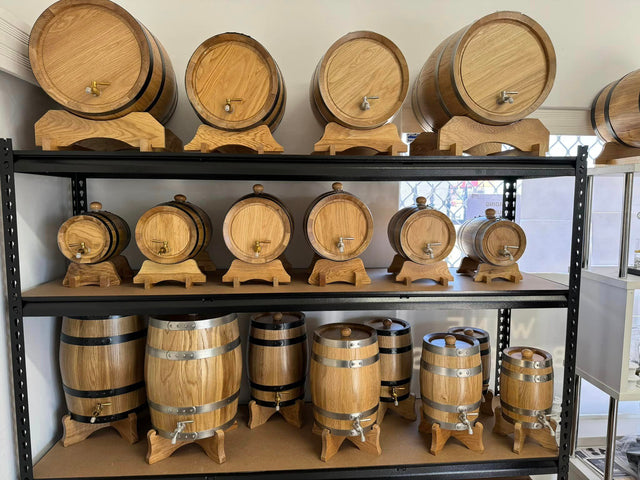Wine Barrels for Beer Brewing
Unleash Unique Flavors
Have you ever pondered the transformative power of a barrel? At Adelaide Wine Barrels, we're no strangers to innovation.
While our barrels have traditionally cradled the finest wines and spirits, a new trend is capturing the imagination of brewers and beer aficionados alike: using wine barrels as beer barrels for storage and adding a unique depth of flavor.
Why Wine Barrels?
The magic lies in the oak. Wine barrels, particularly those from Adelaide, renowned as Australia's wine capital, carry the essence of the premium wines they once held.
When used for beer, these barrels impart nuanced flavors and aromas, ranging from subtle fruity notes to bold, tannic accents.
This process not only enhances the beer's complexity but also bridges the gap between wine connoisseurs and beer enthusiasts, creating a product that appeals to both.

Crafting Your Unique Brew
Using a wine barrel as a beer barrel is not just about storage; it's about transformation. The aging process in an oak barrel allows the beer to undergo a slow, gentle maturation, absorbing the unique characteristics of the wood and the residual wine within.
This method is particularly popular among craft brewers seeking to experiment with and develop distinctive, aged beers.
What flavours can wine barrel offer as your beer barrel
Using wine barrels for aging or flavoring beer introduces a diverse and unique spectrum of flavors, deeply enriching the beer's character. The specific flavors imparted by the wine barrel depend on the type of wine it previously held, the wood of the barrel, and the length of the aging process. Here are some common flavor profiles and nuances that can be achieved:
-
Fruity and Vinous Notes: Beers aged in wine barrels often adopt the fruity, vinous qualities of the wine, which can range from light, white wine grape notes to dark, rich berry flavors from red wine barrels. This adds a layer of complexity and can complement the beer's natural fruitiness.
-
Oak and Vanilla: Oak barrels contribute vanilla tones and a woody complexity, thanks to the lignin in the wood breaking down. This can add a smooth, rounded character to the beer, enhancing its body and depth.
-
Tannins and Dryness: Wine barrels introduce tannins to beer, which can contribute to a drier mouthfeel and a subtle astringency. This can balance the beer's sweetness and add to its structural complexity.
-
Sour and Funky: Barrels previously used for sour wines or those with a microbiome of wild yeast and bacteria (such as Brettanomyces) can impart a sour, funky profile to the beer. This is particularly sought after in wild ales and sour beers, where the goal is to achieve a complex, layered tartness.
-
Spice and Herb: Depending on the wine and the barrel treatment (such as the charring level), beers can also pick up subtle spice notes like cinnamon or clove, or even herbal qualities. These flavors can complement the beer's hop profile or add a contrasting dimension.
-
Toasted and Smoky: The barrel's char level can impart a smoky or toasted character to the beer, adding warmth and richness. This works well with stouts, porters, and other dark beers, providing a comforting, fireside quality.
-
Buttery and Creamy: Some wine barrels, especially those that have influenced Chardonnay with malolactic fermentation, can give a buttery, creamy note to the beer. This can soften the beer's acidity and add a luxurious mouthfeel.
It's important to note that the interaction between the beer and the barrel is a delicate dance, influenced by time, temperature, and the beer's base composition. Brewers meticulously monitor this process to achieve the desired outcome, making each barrel-aged beer a unique testament to the art of brewing. Experimentation and innovation continue to define this exciting field, as brewers and enthusiasts alike discover new possibilities in flavor and craftsmanship
Find similar articles:
Adelaide Beer Barrels Beer Brewing Beer Storage Brisbane Canberra Melbourne SydneyMore stories

The History of Port Barrels

